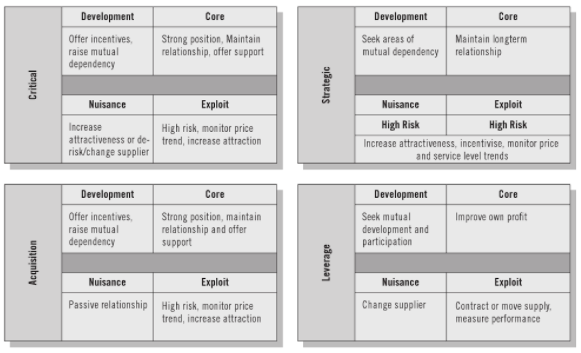The categories/product have been divided into the following segments:
- Strategic items. The development of long-term relationships with partners should be crucial in this segment. We should not forget about supplier evaluation and measuring their performance to control and report the risks arising from those contracts or activities. How to do it effectively? The SRM systems such as NextBuy would be a great support is this case.
- Leverage items. The segment in which we should exploit full of purchasing power to get best negotiation results. In this case online auctions might be really supportive. You can try them in NextBuy (read more on online auctions HERE) .
- Bottleneck items. The main focus is on supply warranty. Product categories in this quarter are not high-value, but critical for proper company operations. That’s why we should focus on decreasing delivery risk rather than on price negotiation.
- Non-critical items. The main focus is on process automation (P2P). Often the process of submitting, accepting and realization of orders is more expensive that the value of the purchase. That’s why we should automate the process. You can do it with the system such as NextBuy ( read one of our blog posts on automation).
The Kraljic matrix works best when building the strategy for particular categories. It allows to look at the company spending globally and group the costs. As a result we get a ready “recipe” on how to manage the category in a particular group.
Why some companies can successfully take advantage of the Kraljic matrix and others, although they use the matrix, cannot get any valuable turnover (meaning, lower price, supply securing, speeding up the process, automation etc.)?
What are the reasons the Kraljic matrix does not bring the assumed effects?
In my opinion there are two main factors which make the Kraljic strategy fail.
- Incorrect segmentation within the matrix
Picture this: 80% of the purchase categories in a company have been classified as strategic items as almost all the products are necessary to company right work. In practice, this scenario would cause procurement team offload (meaning, additional personnel costs or extra hours), no use of the rest of the matrix quarters and their potential and limiting negotiation power.
The strategic items are the ones necessary for business continuity, for example, for a manufacturing company those will be the production products, without which the production stops operating (can you imagine that a production line stops for an hour, two or a day?). In case of a banking sector it can be a server room, but the car fleet rather not. In case of the transport company, the car fleet will be crucial. And so on…
Good purchase organization aims to minimize strategic items’ role by searching alternatives on the market and minimizing the risk. Thanks to that a strategic item can be qualified as a leverage item or non-critical product.
- Not paying attention to the supplier perspective (company “power”’ vs supplier “power”)
The second reason is even more important and makes even best plan for a category may fail.
Procurement is a constant company and supplier interaction. Even though we categorize our products properly, using the Kraljic matrix, we need to ask ourselves a question:
What kind of customer am I for my supplier?
Robert Monczka in his book Purchasing And Supply Chain Management suggests the following customer segmentation from a supplier perspective:
- Core Account – invest and focus on them
- Development Account – has a potential to become a core account, worth to pay attention and extend the cooperation
- Exploit Account – not a part of future plans, increase prices and wait till the account gives up (if he doesn’t, we make good money at least)
- Nuisance Account – no plans to investigate, second category customer.
The most relevant outcome is the table with a Buyer perspective and Supplier perspective. The results are presented on the graphics below (Source: Purchasing and Supply Chain Management. R. Monczka):





